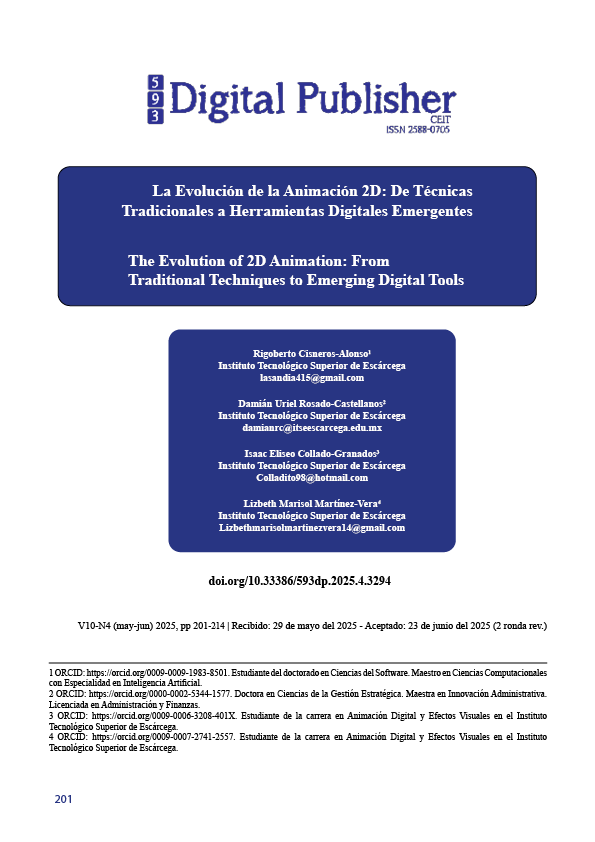The Evolution of 2D Animation: From Traditional Techniques to Emerging Digital Tools
Main Article Content
Abstract
This work offers a comprehensive analysis of the evolution of animation, from its traditional foundations to its status in the contemporary digital era. Based on a rigorous selection of academic sources using the PRISMA methodology, the research delves into essential techniques such as stop-motion and rotoscoping, along with the development of software and compositing tools that have redefined the industry. The article pays particular attention to the technical, narrative, and aesthetic changes resulting from digitalization, without overlooking the stylistic particularities that animation presents in different regions of the world. In short, the work demonstrates that animation is a dynamic field whose evolution is not only technological but also responds and adapts to social and cultural changes, reaffirming its relevance as a powerful medium of expression.
Downloads
Article Details

This work is licensed under a Creative Commons Attribution-NonCommercial-ShareAlike 4.0 International License.
1. Derechos de autor
Las obras que se publican en 593 Digital Publisher CEIT están sujetas a los siguientes términos:
1.1. 593 Digital Publisher CEIT, conserva los derechos patrimoniales (copyright) de las obras publicadas, favorece y permite la reutilización de las mismas bajo la licencia Licencia Creative Commons 4.0 de Reconocimiento-NoComercial-CompartirIgual 4.0, por lo cual se pueden copiar, usar, difundir, transmitir y exponer públicamente, siempre que:
1.1.a. Se cite la autoría y fuente original de su publicación (revista, editorial, URL).
1.1.b. No se usen para fines comerciales u onerosos.
1.1.c. Se mencione la existencia y especificaciones de esta licencia de uso.
References
Cárcel Auñón, B. (2024). Creación de una animación 2D para un cortometraje. Valencia: Escuela Técnica Superior de Ingeniería de Telecomunicación.
Cholodenko, A. (2024). La animación cinematográfica. Semiotic Review , 10. Obtenido de https://doi.org/10.71743/s3p4x084
Cortés-Anaya, N. S.-M.-R. (2023). La fluidez de la animación 2D y 3D. Revista Convicciones, 10(20) 20, 34-40 Fundación de Estudios Superiores Comfanorte.
Damásio, M. &. (2021). Narrativas fragmentadas: exploración de enfoques narrativos para la animación en contexto espacial. International Journal of Film and Media Arts, 6(1), 45-60. Obtenido de https://es.scribd.com/document/737541272/NARRATIVAS-FRAGMENTADAS-EXPLORANDO-ENFOQUES-Narrativos-PARA-LA-ANIMACION-EN-UN-CONTEXTO-ESPACIAL
Das, A. &. (2024). CREATIVE RESURGENCE: THE POPULARITY OF 2D ANIMATION AFTER THE CRISIS. hodhKosh Journal of Visual and Performing Arts, 5(ICETDA24), 376–382. doi:https://doi.org/10.29121/shodhkosh.v5.iICETDA24.2024.1350
Faria, F. &. (2023). The Impact of Hybrid Animation on the Future of Animation. En ArtsIT, Interactivity and Game Creation (11.a ed., Vol. 479, pp. 271-297). doi:Anthony L. Brooks. https://doi.org/10.1007/978-3-031-28993-4_20
Gardiner, E. (2024). 2D animation: the key to growth and adaptation of the South African animation ecosystem. Witwatersrand, Johannesburg: Research and Creative work.
Gómez Balbuena, M. Á. (2024). La reinterpretación de los procesos contemporáneos de diseño y creación de personajes en los largometrajes de animación de Pixar Animation Studios (1995-2017 ). Universidad Complutense de Madrid. Obtenido de https://hdl.handle.net/20.500.14352/107845
Gómez, R. E. (2022). La animación digital en el diseño gráfico. Convicciones|vol. 9, no. 18, 11-16. Obtenido de https://www.fesc.edu.co/Revistas/OJS/index.php/convicciones/article/view/997
Gonzales, M. E. (2024). AniFrame: A Programming Language for 2D Drawing and Frame-Based Animation. arXiv. Obtenido de https://doi.org/10.48550/arXiv.2404.10250
González Pérez, P. &. (2023). La Realidad Virtual para la enseñanza y aprendizaje de la perspectiva en el dibujo. Edutec, Revista Electrónica De Tecnología Educativa, (83), 188–207. doi:10.21556/edutec.2023.83.2681
Hidalgo, J. (2022). El impacto de la animación 3D en la animación 2D en largometrajes estadounidenses de los últimos 20 años. Facultad de Ciencias Sociales y Artes, Escuela de Animación Digital. Obtenido de https://repositorio.umayor.cl/xmlui/handle/sibum/8886
Jarque-Bou, N. R.-S.-I. (2020). ESTUDIO COMPARATIVO DE METODOLOGÍAS DE DIBUJO TÉCNICO PARA ENTRENAR LA VISIÓN ESPACIAL. España: Asociación Española de Ingeniería de Proyectos (AEIPRO). Obtenido de http://dspace.aeipro.com/xmlui/handle/123456789/2578
Karmakar, A. (2021). Investigation of Artistic Styles for Effective Storytelling in animation. Nat.Volatiles&Essent.Oils,2021;8(3):200-209. Obtenido de https://doi.org/10.52783/nveo.5498
Kothenschulte, D. (2020). The Walt Disney Film Archives: The Animated Movies 1921-1968: 40th anniversary edition. Taschen America Llc.
Kovalova, M. A. (2022). The digital evolution of art: current trends in the context of the formation and development of metamodernism. Amazonia Investiga, 11(56), 114-123. doi:10.70088/kqba1d92
Li, S. L. (2022). AnimeRun: 2D Animation Visual Correspondence from Open Source 3D Movies. arXiv. Obtenido de https://doi.org/10.48550/arXiv.2211.05709
Loftsdottir, D. &. (2022). SketchBetween: Video-to-Video Synthesis for Sprite Animation via Sketches. arXivLabs, 27, 1-7. Obtenido de https://doi.org/10.1145/3555858.3555928
Lopera Henao, J. (2022). Estrategias para la optimización de recursos en una producción nacional de animación. LENGUAJE Y CIENCIA, 57.
López Hernández, E. (2023). Concept art para una serie de animación 2D. Valencia: Universidad Politècnica de València. Obtenido de https://riunet.upv.es/handle/10251/199287
López López, L. (2021). Historia técnica de Disney: su influencia en la evolución estética del cine animado occidental. Universidad de Sevilla, Sevilla. Obtenido de https://hdl.handle.net/11441/130355
López Parada, J. A. (2024). La evolución de las técnicas de animación desde sus inicios en 1824 hasta la actualidad [Trabajo de grado, Universidad Autónoma de Occidente]. Repositorio Educativo Digital UAO. https://red.uao.edu.co/server/api/core/bitstreams/32b48171-0552-4f8a-ab51-3ae9b0e1abee/content.
Maksudova, D. (2024). History of Technological Development in Animation till EarlyComputer Graphics. Eur. J. Appl. Sc. Eng. Technol., vol. 2(6), pp. 185-196. Obtenido de https://doi.org/10.59324/ejaset.2024.2(6).18
Marx, C. (2021). Escritura para animación, cómics y videojuegos (2.ª ed.). CRC Press. Obtenido de https://doi.org/10.1201/9781351215985
Maselli, V. (2021). The Evolution of Stop-motion Animation Technique Through 120 Years of Technological Innovations. Rome, Italy: International Journal of Literature and Arts 54-62. Obtenido de https://doi.org/10.11648/j.ijla.20180603.12
Mitchell, B. (2023). Animación independiente: Desarrollo, producción y distribución de películas de animación (2.ª ed.). CRC Press. https://doi.org/10.1201/9781003214717.
Muhammad Suhaili, F. M. (2024). Análisis en la realización de movimientos de animación utilizando métodos tradicionales (fotogramas clave) y métodos de captura de movimiento. KnE Engineering Páginas: 652–655. doi:10.18502/keg.v6i1.15455
Nieto, Y. (2024). Tendencias y avances en la animación digital. EntrelineasEntre Líneas - Noticias de Chihuahua. Obtenido de https://entrelineas.com.mx/mundo/tendencias-y-avances-en-la-animacion-digital/
Page MJ, M. J.-W. (2021). The PRISMA 2020 statement: an updated guideline for reporting systematic reviews. BMJ. 2021 Mar 29;372:n71. doi:10.1136/bmj.n71. PMID: 33782057; PMCID: PMC8005924
Pertíñez López, J. .. (2022). Procesos híbridos en animación experimental. Revista Internacional de Cultura Visual Revista Internacional De Cultura Visual , 11 (4), 1–9. doi:https://doi.org/10.37467/revvisual.v9.3700
Pestano López, E., & Vegas Rodríguez, C. (2023). Código Lyoko, la referencia de la animación paralela. Latente Revista De Historia Y Estética Audiovisual, 21, 111–130. Obtenido de http://riull.ull.es/xmlui/handle/915/34260
Razeef Shah, M. &. (2022). Investigación de las diferencias narrativas entre la animación por ordenador occidental y oriental. Proceedings of the International Conference on Animation and Digital Media, 78-79.
Rodríguez Vicente, A. J. (2020). Animación 2D y realidad virtual. Game over: cambio climático. Repositori Institucional O2. Obtenido de http://hdl.handle.net/10609/105407
Ruíz, J. (2020). Historia de la Animación. Quito, Ecuador: CIESPAL: Chasqui: Revista Latinoamericana de Comunicaciòn.
Ruíz, J. (2020). Historia de la Animación. Chasqui 50: 4-6. Cespial. Obtenido de http://hdl.handle.net/10469/13143
Sandra, S. C. (2020). Colorful Morning III: Clean-up, fondos, color, iluminación y post-producción para un corto publicitario de animación 2D. Facultat de Belles Arts de Sant Carles.
Santos Criollo, P. E. (2022). El storyboard y la animática como herramientas en la animación 2D y 3D. Ecuador: Universidad De Cuenca. Obtenido de http://dspace.ucuenca.edu.ec/handle/123456789/38981
Soto, C. y. (2023). Klaus: una Innovación en la técnica visual 2D. Facultad de Ciencias Sociales y Artes, Escuela de Animación Digital. Obtenido de https://repositorio.umayor.cl/xmlui/handle/sibum/8891
Tang, Y. G.-X. (2025). Generative AI for Cel-Animation: A Survey. arXiv. Obtenido de https://doi.org/10.48550/arXiv.2501.06250
Tous, R. (2024). Lester: animación rotoscópica mediante segmentación y seguimiento de objetos de vídeo. Algorithms, 17(8), 330. Obtenido de https://doi.org/10.3390/a17080330
Ulloa Clavijo, A. (2023). Inire. Biblia de animación para el cortometraje 2D sobre la frustración de una artista en búsqueda de inspiración. Universidad Autónoma de Occidente. Obtenido de https://hdl.handle.net/10614/14806.
Valdivieso, A. &. (2021). Actualización de las técnicas 2D en la animación contemporánea. Granada: Universidad de Granada. Obtenido de https://hdl.handle.net/10481/98941
Valdivieso, M. C. (2025). Smears en animación: una exploración de la técnica y su impacto en la narrativa visual. Dialnet. Obtenido de https://dialnet.unirioja.es/servlet/articulo?codigo=9937379
Vargas, M., & Arévalo, K. (2023). El impacto evolutivo de la animación y su beneficio en el diseño gráfico. Fundación de Estudios Superiores - F ESC. doi:DOI: 10.13140/RG.2.2.15668.01928
Vargas, M., & Arévalo, K. (2023). El Impacto Evolutivo De La Animación Y Su Beneficio En El Diseño Gráfico. Fundación de Estudios Superiores - FESC. doi:10.13140/RG.2.2.15668.01928
Vertudazo, R. T. (2024). Enhancing animation workflow: Design and development of an advanced animation table for traditional animation production. Revista Internacional de Gestión yd Ciencias Sociales Volumen 12 Número 1. doi:10.13140/RG.2.2.20419.37929
Villanueva, A. F. (2023). El uso de motion graphics y animación de personajes 2D para videos de divulgación científica. Universidad Peruana de Ciencias Aplicadas. Obtenido de http://hdl.handle.net/10757/670447
Vundela Sivakrishna, R. &. (2023). Revolutionizing animation: unleashing the power of artificial intelligence for cutting-edge visual effects in films. Soft Computing, 28(1), 749-763. Obtenido de https://doi.org/10.1007/s00500-023-09448-3
Wei, W. (2024). The evolution of digital art: from early experiments to contemporary practices. International Journal of Literature and Art Innovation., 1(1), 44–49. doi:10.70088/kqba1d92
Yuquilema, M. P. (2022). Técnicas y principios de animación: Caso de estudio serie Fantasmagorias, La Llorona. Dom. Cien., 8(3), 1396–1413. doi:http://dx.doi.org/10.23857/dc.v8i3
Zhu, C. W. (2021). Application of computer graphic technology in animated scene. Learning & Education, 9(4) (126-129). Obtenido de https://api.semanticscholar.org/CorpusID:233675701





